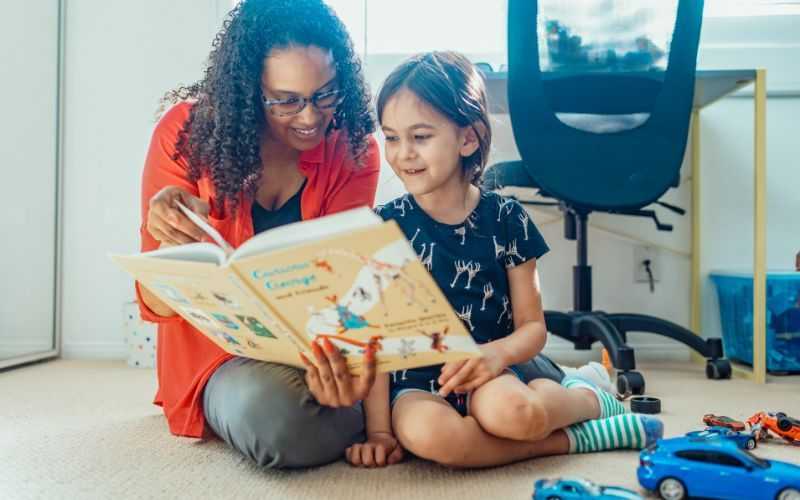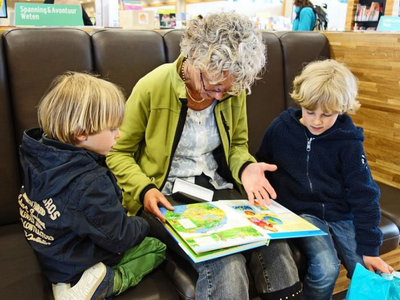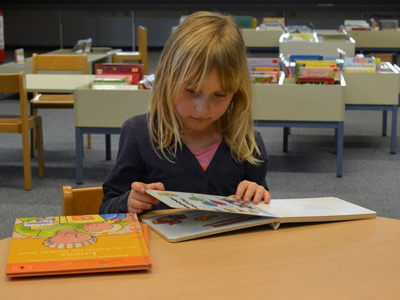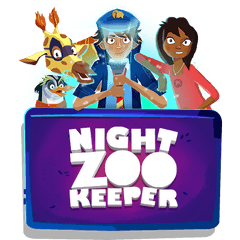Teach a Child to Read in 6 Simple Steps


Learning to read is one of the most important things your child will do in their life. Most people don’t start thinking about how reading is taught until they have a child of their own who needs to learn. There are lots of conflicting opinions out there about the best methods for teaching a child to read. If you are a busy parent, you might not have time to sift through them all!
The process of learning to read can be challenging for children, and each child will learn at their own pace, but the best way to tackle the challenge is by making reading fun and enjoyable.
In this article, we’ll cover some great ways to teach your child to read.

1. Read to your child
Spend lots of time reading to your child, especially at a young age. Start with picture books and texts with simple sentences.
Read slowly, and point out each word as you read them out loud. If you read a story over and over again, your child will start to associate certain sounds and pictures that can be revisited within a book.
Make sure that your reading environment is warm and snuggly. Perhaps your child can bond with you sitting in your lap, or you read them a bedtime story when they’re tucked in. This will help associate reading with comfort and positivity, which will encourage them to read more.
As you read, perhaps make personal associations with the text you’re reading, so that your child can understand better. If your picture book is explaining the letter “c” and you have a family cat, try bringing up the cat to make the association to the letter for your child.
Having a routine of reading to your child is incredibly important. If they are very young, have soft books among your child’s toys. As your child gets older, introduce rhyming books by authors like Dr. Suess, or Shel Silverstein.
You can’t really start too early in reading to your child. Reading is so important for their cognitive development. In this article we cover why it’s essential for their development, as well as many other reasons why reading is important for children.
2. Link sound to words
Learning phonics is essential for a child’s reading development. Phonics is where children connect the sounds of spoken language with written words. This is one of the earliest reading skills a child should learn because it helps them understand that there is a link between letters and sounds.
To start teaching phonics, focus on letter sounds over letter names. There are plenty of beautiful ABC books out there to start introducing letters to your child.
Of course, you might be tempted to start by teaching your child the alphabet in order. We recommend that you start with words your child is more familiar with, such as their name, or perhaps the starting letter of their favorite toy.
Your child has to master what a letter looks like visually and then link it to a particular sound. It’s best to start by teaching the sound that the letter makes (although we are aware that many letters have multiple sounds when added to words). For instance, the letter B should be taught as the sound /b/ (buh) instead of how we say the letter (bee). This way, when a child starts sounding out the word they are reading (such as ball) they will be able to associate the sound with the word (/b/all). Eventually, you want your child to recognize that the letter b represents the /b/ sound and is the first letter of the following words: ball, boy, bus.
There is a reason that the alphabet has its own song! To practice linking the sounds of letters to words, you can turn to songs and rhymes for repetition and recognition.
If you’d like to play sound games, you could play “I Spy” but for certain letter sounds. For instance, if you are focusing on the letter b, you could ask your child to find things in the room that start with the letter b.
When walking outside you can point to different sign posts, street signs and other printed words and point out what they say and what they are.

3. Help your child sound out words.
Once your child has a hold on initial phonics, they will start to practice phonemics. Phonemics is linked to phonics in the sense that it focuses on sounds. It helps children understand that words are made up of unique individual sounds, as well as syllables.
Once your child has mastered the beginning sound of a word, help them try to sound out the read of the word to get to the ending. Start with a one syllable word like “bat’. Once your child has mastered the beginning sounds, you can start grouping familiar words together, like “sat”, “pat” and “mat”.
Not only will your child realise that they can read these words, but you can also remind them that these words rhyme.
Once your child has mastered one syllable words, try adding words with two syllables and onward.
4. Introduce Sight Words
Sight words are words that children are told to recognize on sight, as they are either frequent in language or hard to sound out. There are two kinds of sight words - high frequency words and non-phonetic words.
High frequency words are words that appear most often in language (for example: the, is, and, I and he, etc).
Non-phonetic words are words you can’t easily read by sounding out. (for example: high, one, two, and does, etc).
You can teach sight words in a variety of ways.
One easy way is by putting the word on a flashcard. You can teach your child how to pronounce the word, the definition of the word, as well as how to use the word in a sentence. You should use these flashcards until your child has committed it to memory.
You can also associate words with certain objects or drawn images. Children will start getting visual links to the word as they practice recognizing them on sight.

5. Create an encouraging, reading-friendly environment.
Make reading a priority in your child's routine, and ensure it is regular and interesting. Incorporate reading to your child, reading with your child and your child reading to you. Give your child a dedicated quiet space for them to focus on reading without distractions.
If you’re reading to them, read animatedly and add emphasis to particular words. Stop and make personal connections so that your child can connect with the words being read.
If your child is beginning to read, have them point out basic words on the page and try to sound it out. Have them take turns in reading a sentence or two to you.
If you have your child read to you, let them go at their own pace and listen when they pause on certain words. Make sure to ask them questions about what they are reading so you can confirm that they actually understand.
However you choose to spend reading time, make sure your child is engaged and wants to come back for more!
6. Play literacy games
There are many online and offline reading games available to help children improve their skills. Gamified learning often works well in engaging even the most reluctant learners. This is because it incorporates an element of fun in the learning process. Whether you purchase games, or make them yourself, we do encourage you to use fun learning games as a teaching method.

We prioritize gamification at Night Zookeeper! There are a range of different learning games to help improve reading skills.
Depending on their age and reading level, your child will be able to practice phonics, sight words, typing and reading comprehension. For instance, in one of our learning games Vincent’s Gallery, the game presents images to students and challenges them to select the word that best represents the picture. This game is just one of our growing collection of picture-led comprehension games developed with younger learners in mind.
In Penguins Paragraphs children are presented with grade-level digital storybooks. The texts have missing words and the child needs to use comprehension skills to determine where the missing words go.
With these six steps, your child will start their reading journey on the right path. By incorporating Night Zookeeper into a homeschool language arts curriculum or as a tool to keep your child engaged, you can positively impact your children’s love for reading.
Sign up today to get a FREE 7-day trial!
Got any questions? Reach out to us by email at support@nightzookeeper.com. Follow us on social media for more tips, activities, and regular updates:


Make Reading & Writing Fantastically Fun!
- Award-winning reading & writing program for kids
- Improves spelling, grammar, punctuation & vocabulary
- Over 1,000 different learning games and activities


Why Is Reading Important For Children?


“My child hates writing.” What do I do?


25 Creative Writing Prompts for Kids


